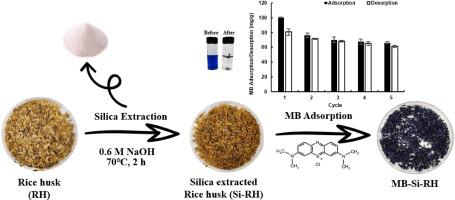稻壳零废弃物的实现方法:二氧化硅萃取-亚甲基蓝吸附
IF 5.8
2区 化学
Q2 CHEMISTRY, MULTIDISCIPLINARY
引用次数: 0
摘要
本研究确定了从稻壳(RH)中提取Si的最佳工艺条件,以实现RH的高效资源化利用,并对Si萃取的RH (Si-RH)对亚甲基蓝(MB)的吸附特性进行了评价。从RH中提取二氧化硅的最佳工艺条件为:0.6 M NaOH(1:10)与RH (>2 mm)混合,在70℃下反应2 h。扩大表面积、增强纤维素-半纤维素-木质素基质的Si-RH对MB的最大吸附量为99.01 mg/g,是RH (34.36 mg/g)的3倍,更符合Langmuir等温线和拟二级模型。结果表明,Si-RH对MB的吸附受反应时间、pH、投加量、反应温度等环境因素的影响较大。SEM-EDS和FTIR的表面性质以及吸附模型方程表明,Si-RH对MB的吸附是由复杂的机理主导的,而不是单一的机理,这些都对Si-RH对MB的初始吸附-解吸过程产生了很大的影响。在连续的吸附-解吸实验中,Si-RH对MB表现出了优异的吸附效率。综上所述,本研究提出的从RH中提取二氧化硅并将其残渣用作染料吸附剂是实现RH零浪费的最佳方法。本文章由计算机程序翻译,如有差异,请以英文原文为准。

Zero waste realization method of rice husk: Silica extraction and methylene blue adsorption
This study determined the optimal conditions for extracting Si from rice husk (RH) for efficient resource utilization of RH and evaluated the adsorption characteristics of methylene blue (MB) by Si-extracted RH (Si-RH). The optimal conditions for extracting silica from RH were mixing 0.6 M NaOH (1:10 ratio) with RH (>2 mm) and reacting at 70 °C for 2 h. The maximum adsorption amount of MB by Si-RH with expanded surface area and reinforced cellulose-hemicellulose-lignin matrix was 99.01 mg/g, which was three times higher than that of RH (34.36 mg/g), and better fit the Langmuir isotherm and Pseudo-second order models. It was found that the adsorption of MB by Si-RH was greatly affected by environmental changes such as reaction time, pH, dosage, and reaction temperature. The surface properties by SEM-EDS and FTIR and the adsorption model equation showed that the adsorption of MB by Si-RH was dominated by complex mechanisms rather than a single mechanism, and these greatly influenced the initial adsorption-desorption process of MB by Si-RH. In continuous adsorption-desorption experiments, Si-RH showed excellent adsorption efficiency for MB. In conclusion, the extraction of silica from RH and utilization of the residue as a dye adsorbent proposed in this study is considered to be the optimal method for realizing zero waste of RH.
求助全文
通过发布文献求助,成功后即可免费获取论文全文。
去求助
来源期刊

Sustainable Chemistry and Pharmacy
Environmental Science-Pollution
CiteScore
8.20
自引率
6.70%
发文量
274
审稿时长
37 days
期刊介绍:
Sustainable Chemistry and Pharmacy publishes research that is related to chemistry, pharmacy and sustainability science in a forward oriented manner. It provides a unique forum for the publication of innovative research on the intersection and overlap of chemistry and pharmacy on the one hand and sustainability on the other hand. This includes contributions related to increasing sustainability of chemistry and pharmaceutical science and industries itself as well as their products in relation to the contribution of these to sustainability itself. As an interdisciplinary and transdisciplinary journal it addresses all sustainability related issues along the life cycle of chemical and pharmaceutical products form resource related topics until the end of life of products. This includes not only natural science based approaches and issues but also from humanities, social science and economics as far as they are dealing with sustainability related to chemistry and pharmacy. Sustainable Chemistry and Pharmacy aims at bridging between disciplines as well as developing and developed countries.
 求助内容:
求助内容: 应助结果提醒方式:
应助结果提醒方式:


